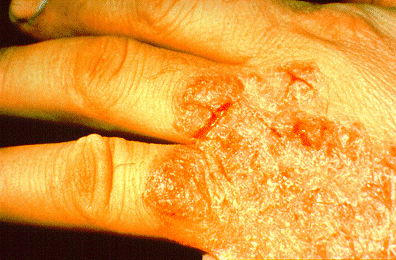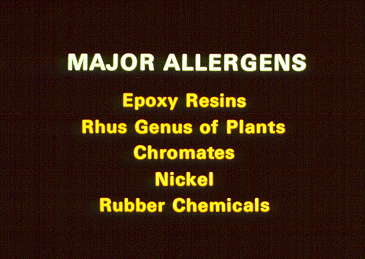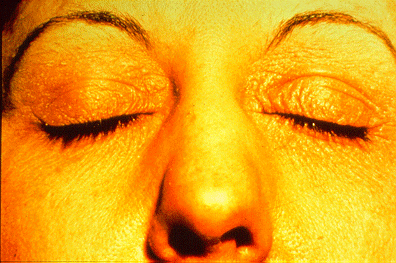Occupational Dermatoses
NOTE: This page is archived for historical purposes and is no longer being maintained or updated.
Slides 41 to 45
Slide 41 - Cutting fluids, eczematous

Since these fluids are generally alkaline, machinists whose hands and forearms undergo prolonged exposure to them, frequently develop dermatitis. While impermeable gloves might prevent this, they may interfere with dexterity and pose a safety hazard around moving machinery.
Slide 42 - Allergy mechanisms

Allergic contact dermatitis is an example of cell mediated immune response. The main cells responsible for the reaction in sensitized individuals are T-lymphocytes. The chemicals that sensitize easily are usually of low molecular weight, fat soluble and reactive with tissue proteins. The chemicals themselves are haptens, or incomplete antigens, forming conjugates with tissue proteins. The hapten-protein conjugates are the complete antigens.
For allergic contact dermatitis to occur, a period of 5-7 days of more is required for incubation. Thereafter, the sensitized lymphocytes react to further encounters with the sensitizing antigen within a period of 24 hours after contact.
Slide 43 - Major chemical allergens

In industry the most common causes of allergic contact dermatitis include epoxy resins, Rhus genus of plants, chromates, nickel and rubber chemicals.
Slide 44 - Epoxy resins

Although completely cured resins are inert, the production and application of epoxy resin system, with modifiers and hardeners that are frequently sensitizers, carry the risk of both primary irritant and allergic reactions. This dermatitis on the eyelids - a typical site for dermatitis from airborne substances - was caused by the vapor of an amine hardener used in curing epoxy resins.
Slide 45 - Other Resin System
This photo was removed due to privacy concerns.
This severe allergic contact dermatitis was due to a phenol-formaldehyde resin. These resins are used as bonding agents for foundry sand, electrical devices and in molded and cast plastic articles. They may also produce irritant reactions.
- Page last reviewed: January 5, 1998 (archived document)
- Content source:
- National Institute for Occupational Safety and Health Health Effects Laboratory Division (HELD)


 ShareCompartir
ShareCompartir